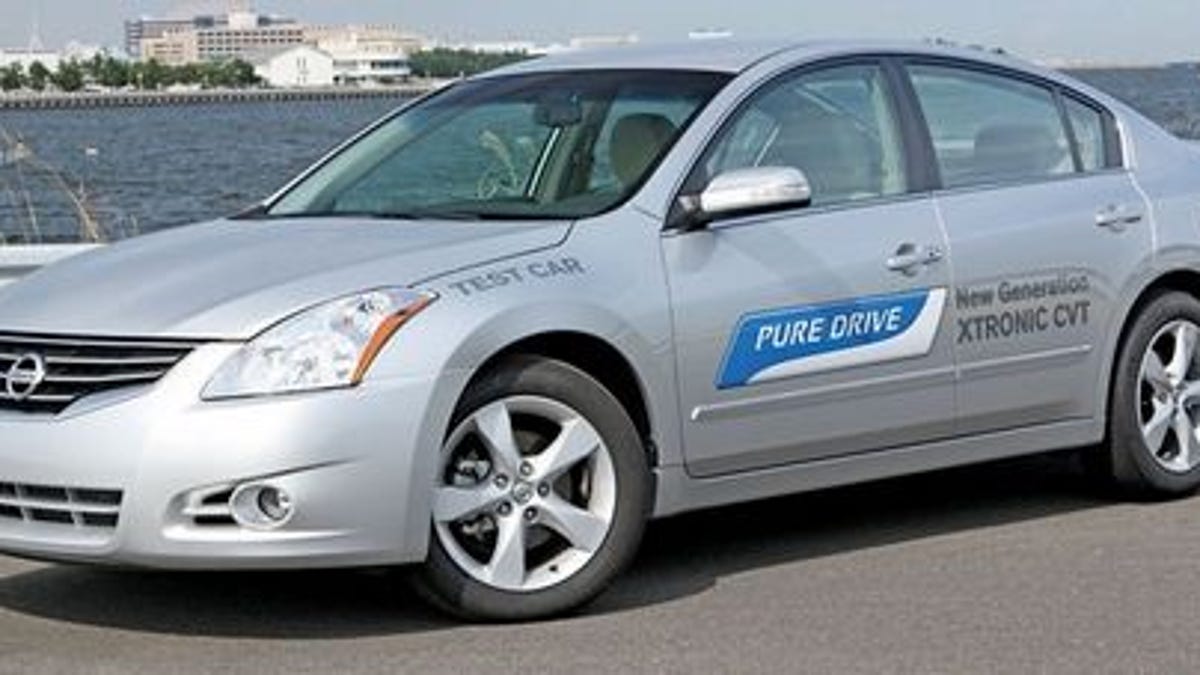Nissan adds drivetrain and safety features for mass-market models
Automotive News reports on how Nissan will add continuously variable transmissions and hybrid power trains across its model lineup.

YOKOSUKA, Japan--Nissan Motor, which has made technology a keystone of its midterm business plan, last week unveiled new hybrid and CVT power trains for North America and said it would install a wide range of high-tech safety features on low-priced, mass-market models.
The new hybrid drivetrain is the first front-wheel-drive electric-gasoline system developed in-house by Nissan. It puts Nissan back in the hybrid race after announcing plans in June to discontinue the Altima Hybrid, the brand's only hybrid offering.
The hybrid package arrives in North America in 2013. Nissan declined to say what model would get the new hybrid system, but the Altima is a prime candidate.
Nissan also is rolling out an improved continuously variable transmission, which will arrive next year and is expected to go into such midsized vehicles as the Altima sedan. The next-generation pulley-type transmission will boost fuel efficiency 10 percent over today's version.
Nissan showed the power train and safety advancements during a Wednesday, October 12, test-drive event at the carmaker's Oppama proving grounds south of Tokyo.
Technology blitz
Japan's No. 2 automaker is embarking on a technology blitz under the Power 88 midterm business plan that CEO Carlos Ghosn unveiled in June. The blueprint calls for introducing 90 new technologies through the fiscal year that ends March 31, 2016--or 15 new features a year.
Nissan is banking heavily on electric vehicles, but eking out better mileage from the standard internal combustion engine and improving safety systems also are top priorities.
A key theme of the new safety technologies is developing low-cost sensor systems for use in inexpensive mass-market models across the Nissan lineup.
Nissan already has an upscale, all-around sensor system for such things as lane departure, blind spot intervention, backup collisions, and forward collisions. It combines sensing with a control function such as automatic braking or lane correction.
But that system is pricey because it uses millimeter-wave radar sensors and several cameras placed around the car. So far, it is mostly relegated to high-end models in the Infiniti lineup.
The new safety technologies are a fraction of the price because they employ only one camera. And instead of triggering a control function, such as automatic braking, they simply warn the driver. They will start appearing next year and eventually will be offered on all Nissan models, the company says.
Safety for the masses
The first low-cost system to be deployed will be a camera-based rear danger alert. It will warn about blind spots, lane departure, and objects moving behind the vehicle when a driver is backing up.
Nissan expects the feature to spread quickly through its U.S. fleet following recent regulations mandating rear cameras in new cars after 2015. Within a year or two of bringing out the rear camera sensor, Nissan will add a forward-sensing camera system.
Each of those systems will cost less than ¥20,000, or about $260, reckons Masao Fukushima, Nissan's engineering director for information technology. That compares with a cost of around ¥270,000, or $3,511, for the top-shelf, radar-based system used for Infiniti.
Nissan also is planning two other sensing technologies in the next two years:
-- A predictive forward-sensing system that monitors two cars ahead.
-- An accelerator-suppression system to fight pedal misapplication.
The predictive sensing system will be used in premium nameplates at first. Using millimeter-wave radar, it can keep tabs not only on the car in front but the car in front of that one, too.
The idea: Give the driver advanced warning about objects out of the field of vision, such as when the car in front suddenly swerves to pass a slower car. A warning sounds, and the seat belts automatically tighten to alert the driver to the new obstacle in the car's path.
The pedal-misapplication technology aims to prevent accidents caused when drivers accidentally step on the gas when they think they are slamming on the brakes. Nissan says pedal misapplication causes 7,000 accidents alone in Japan each year, often during parking.
By using sonar and around-view cameras, the car can detect if it is in a parking spot and whether there are obstacles such as other cars, pillars, or walls. If the system determines the car is in parking mode, it suppresses acceleration, even if the driver excessively applies the gas pedal.
It then sounds a warning if the car is about to hit something. And if the driver takes no evasive action, the new feature automatically engages the brakes to stop the car before impact.
Nissan plans to wrap the feature into a new, low-priced all-around camera, not offer it as a standalone option, because most customers don't peg themselves as the type to misapply pedals.
"Most people believe they are safe drivers, so even if you try to sell this technology to them, they will not be willing to buy it," Fukushima says. "But an around-view monitor actually offers high value to them because it allows the driver to know what's going on around the vehicle."
(Source: Automotive News)